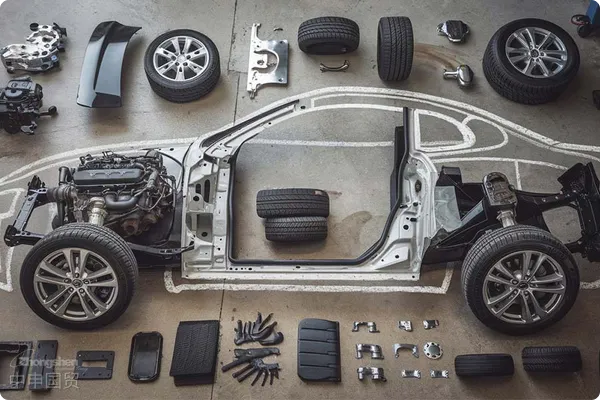- Shanghai Zhongshen International Trade Co., Ltd. - Two decades of trade agency expertise.
- Service Hotline: 139 1787 2118

Automotive partsImport RepresentationMarket Prospect Analysis: Opportunities and Breakthrough Strategies in Industry Transformation
Author:ZhongShen International Trade
Contents
ToggleI. The Transformation of the Global Automotive Industry Reshapes the Import Auto Parts Market Landscape
In theNew energyAgainst the backdrop of an automotive penetration rate exceeding 18% (2023 data) and the accelerated implementation of autonomous driving technology, the global automotive parts market is undergoing a structural transformation. As industry professionals with 20 years of experience, we have observed three major trends profoundly impacting the import agency business:
1.Technological generational gaps create market discontinuities.
In mature markets such as Europe, the U.S., and Japan, ADAS intelligent driving systems have achieved widespread adoption (with a penetration rate exceeding 75%), while developing countries still primarily focus on demand for basic accessories. This technological gap has led to sustained strong demand for imported high-end components, particularly intelligent modules like millimeter-wave radars and domain controllers, with an average annual import growth rate of 32% over the past three years.
2.New energy vehicles reconstruct the supply chain system.
The import share of the three-electric system (battery/motor/electronic control) surged from 8% in 2019 to 41% in 2023, with over 90% of components requiring higher technical thresholds—such as thermal management systems and 800V high-voltage fast-charging modules—still relying on imports. Although Tesla's Shanghai Gigafactory has achieved a localization rate of 95%, its core BMS chips remain 100% imported, highlighting the market opportunities created by technological barriers.
3.Regional certification barriers give rise to demand for professional services.
The newly implemented EU CSRD Sustainable Supply Chain Regulation (2023) and the localization procurement clauses in the U.S. Inflation Reduction Act have increased the compliance costs of component imports by 40%. For instance, a German braking system brand we serve once had an entire container detained at the port for 35 days due to non-compliant IMDS material data declarations, resulting in losses exceeding 2 million yuan.
II. Four Major Value Growth Points of Import Agency Business
According to the 2023 data from the General Administration of Customs, China's auto parts imports reached $42.7 billion, marking an 11.6% year-on-year increase, with three major business segments experiencing explosive growth:
1. Technical Certification Value-Added Services (Profit Margin Increase of 30-50%)
A U.S.-owned TPMS (Tire Pressure Monitoring System) manufacturer successfully expanded its market to 22 countries by utilizing our bundled certification services for EU ECE R141 and Russian EAC. The certification process was shortened from 14 months to 9 months.
2. Bonded Supply Chain Solutions (Inventory Turnover Rate Increased by 3 Times)
For high-value precision components (such as LiDAR), the pre-bonded warehouse solution we designed for an autonomous driving company achieves a 72-hour emergency replenishment response and reduces capital occupancy by 60%.
3. Anti-Dumping Circumvention Guidance (Avoiding 30-100% Punitive Tariffs)
In the U.S. anti-dumping case against Chinese aluminum wheel hubs, we assisted the client in maintaining their North American market share through a Malaysia transshipment processing + origin reconfiguration solution, with the total cost increasing by only 8%.
4. Digitalized Customs Clearance System (70% Improvement in Clearance Efficiency)
The self-developed intelligent classification system has increased the HS code recognition accuracy for nearly 10,000 automotive parts to 98.6%, reducing the customs clearance time for a mixed container shipment involving 283 SKUs to just 1.8 hours.
III. Key to Market Breakthrough in the Next Five Years
Based on Roland Berger's "2024 Global Automotive Aftermarket Report" and our hands-on experience serving over 300 international brands, we recommend focusing on the following strategic directions:
1. Establish a technical barrier identification system.
Develop a tiered database for accessory technologies, with a focus on high-value-added products compliant with new regulations such as UN R155 (Cybersecurity) and R156 (Software Update). An Italian automotive lighting company completed the compliance upgrade of matrix LED headlights 18 months ahead of schedule through our regulatory forecasting service.
2. Layout of regional hub central warehouses
Within the RCEP region, a Japanese piston ring manufacturer established a triangular network consisting of a "Singapore Digital Customs Center + Thailand Distribution Warehouse + Vietnam Assembly Base," thereby reducing the delivery cycle in Southeast Asia from 22 days to 7 days.
3. Develop reverse supply chain capabilities
For the import business of retired batteries from new energy vehicles, we designed a "Hong Kong testing + Hainan remanufacturing + mainland sales" model for a South Korean company, successfully bypassing the import restrictions on power batteries and achieving a profit margin 2.3 times the industry average.
4. Building a Data Middle Platform to Empower Customers
By integrating real-time data from 47 global ports, our clients can accurately predict supply chain risks. During the 2023 Red Sea crisis, the early warning system advised clients 72 hours in advance to reroute via the Cape of Good Hope, preventing delays for 98 containers.
IV. Survival Strategies During Industry Reshuffling
Under the regulatory environment where the General Administration of Customs is comprehensively promoting "Smart Customs 2024" and the EU implements the Carbon Border Adjustment Mechanism (CBAM), the survival space for traditional agents is narrowing. We recommend:
1.Invest in the construction of a technology compliance laboratory(The cost per test is reduced by 60%)
2.Obtain AEO Advanced Certification Qualification(Inspection rate reduced to below 0.5%)
3.Develop an accessory lifecycle management system.(Extend customer LTV by 3-5 times)
4.Establish overseas compliance entities(Avoiding geopolitical risks)
Conclusion
The import agency for automotive parts has evolved from a simple "logistics intermediary" to a "technical compliance steward + supply chain architect." Service providers capable of deeply integrating industry insights, digital technology, and compliance capabilities will dominate the market landscape in the next five years. This $300 billion sector is awaiting the emergence of true industry consolidators.
Related Recommendations
? 2025. All Rights Reserved. Shanghai ICP No. 2023007705-2  PSB Record: Shanghai No.31011502009912
PSB Record: Shanghai No.31011502009912









